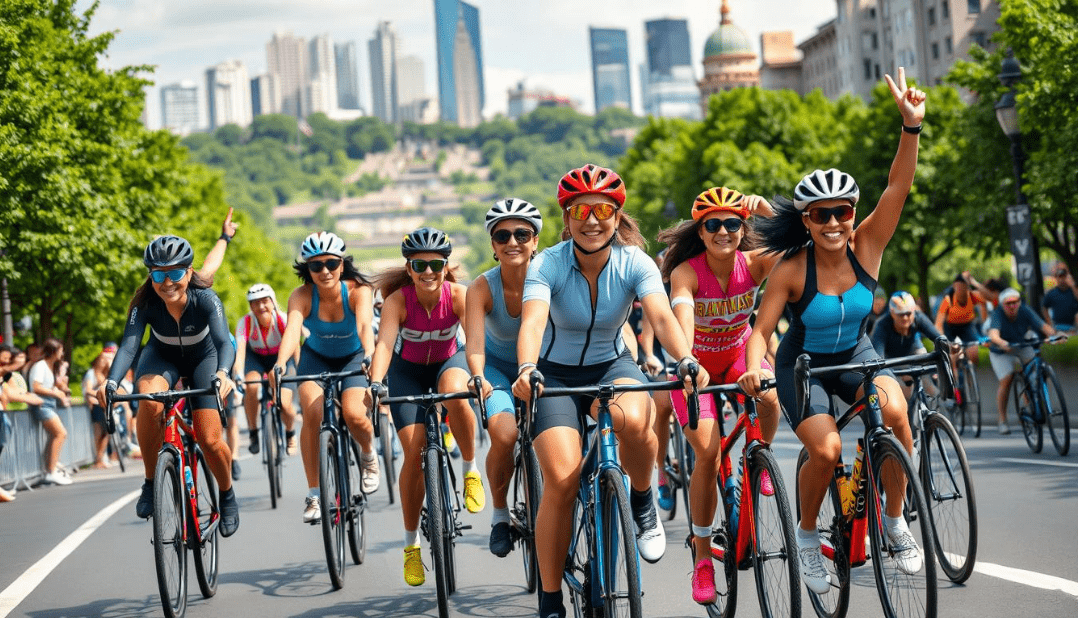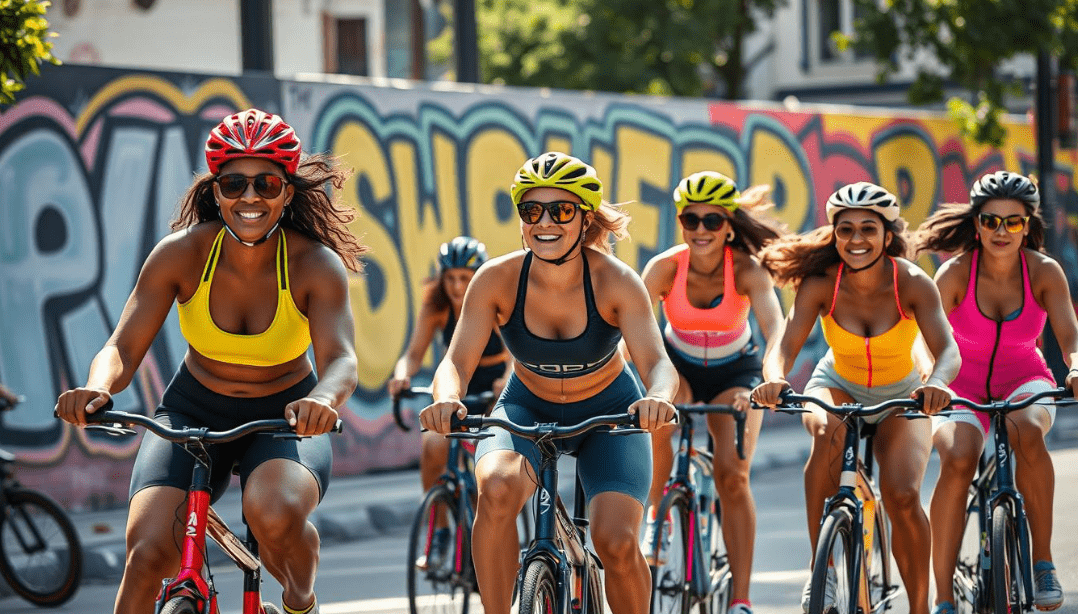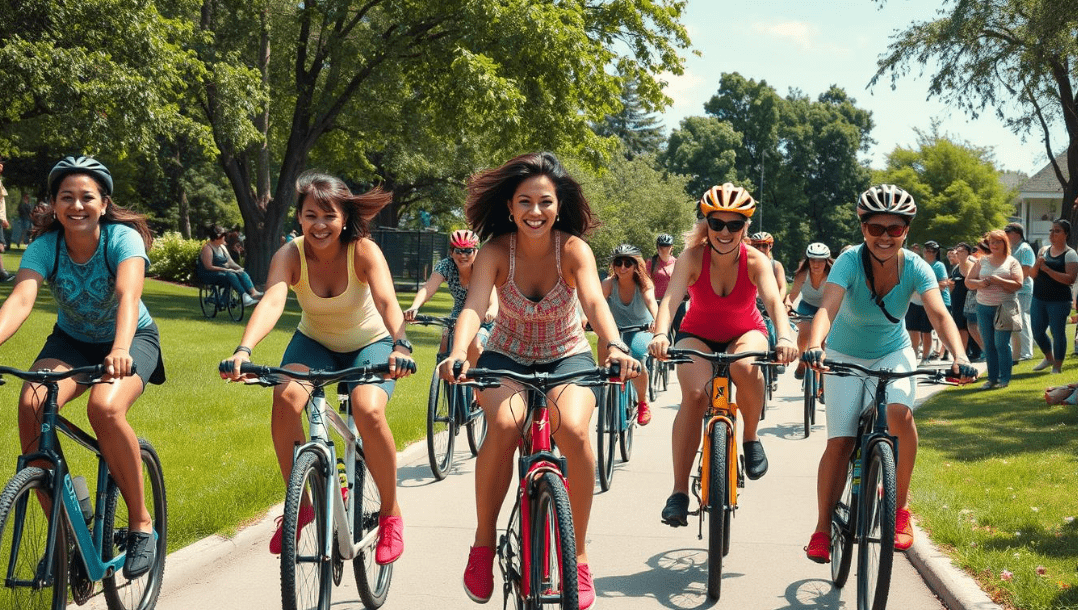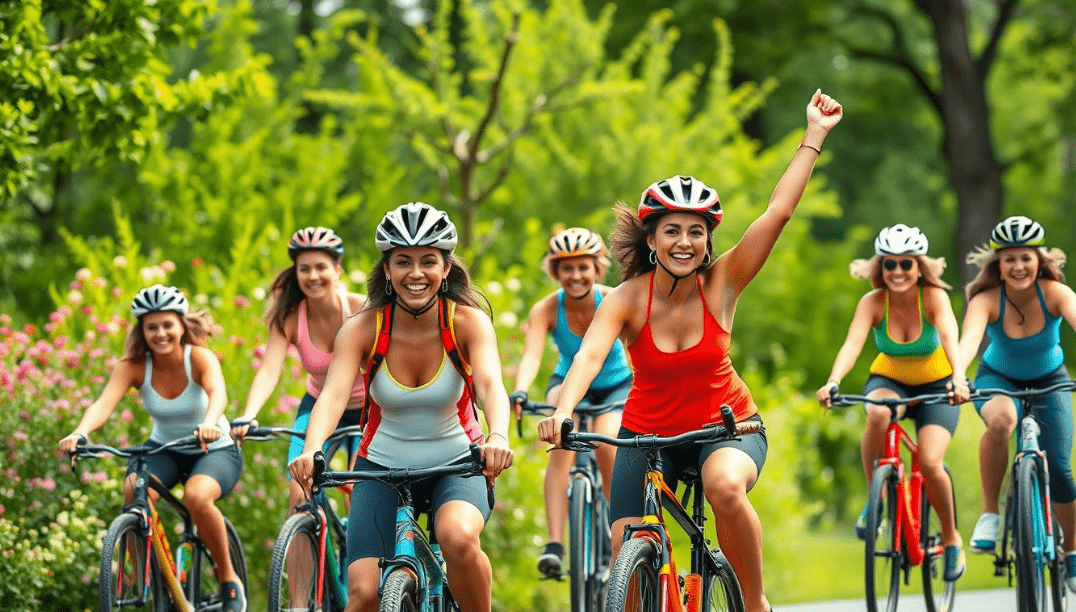Contents
- 1 Women Cyclists: Empowering Riders
- 1.1 The Historical Impact of Women in Cycling
- 1.2 Women Cyclists: Challenging Gender Norms and Stereotypes
- 1.3 The Rise of Women-Centric Cycling Communities
- 1.4 Breaking Down Barriers: Accessibility and Inclusivity in Cycling
- 1.5 The Economic Impact of Women in the Cycling Industry
- 1.6 Health and Wellness Benefits for Women Cyclists
- 1.7 Cycling as a Vehicle for Social Change
- 1.8 Overcoming Challenges: Safety and Infrastructure for Women Riders
- 1.9 Inspirational Stories of Women Cyclists Around the Globe
- 1.10 The Future of Women’s Cycling: Trends and Predictions
- 1.11 FAQ
- 1.11.1 What is the historical significance of women in cycling?
- 1.11.2 How have women cyclists challenged gender norms and stereotypes?
- 1.11.3 How are efforts being made to increase accessibility and inclusivity in cycling for women?
- 1.11.4 What is the economic impact of women in the cycling industry?
- 1.11.5 What are the health and wellness benefits of cycling for women?
- 1.11.6 What challenges do women cyclists face, and how are they being addressed?
- 1.11.7 What are the future trends and predictions for women’s cycling?
Women Cyclists: Empowering Riders
I’ve always been captivated by the transformative power of cycling. Witnessing women cyclists find empowerment through pedaling has been enlightening. Their journey is one of overcoming obstacles, defying conventions, and making a profound impact.
Women’s cycling has evolved significantly since the 1880s, when the Rover Safety Bicycle paved the way. Today, it transcends mere transportation or sport, reshaping societal norms. Women’s cycling has come a long way since the 18 Empowering Women Cyclists: Revolutionizing Societal Norms and Inspiring Change 80s, when the Rover Safety Bicycle kick-started a revolution. Beyond being a means of transportation or a sport, it has become a catalyst for societal change. From challenging gender norms to fostering inclusivity, women cyclists are making their mark on the road and inspiring others to pedal forward.
Despite advancements, the path forward for women cyclists remains challenging. Women comprise less than 25% of cyclists, highlighting a substantial gender disparity. The recent inclusion of women in the Tour de France is a significant step, yet it also highlights the slow pace of change in elite cycling.
BEST SELLING WOMENS CYCLING ACCESSORIES: CLICK HERE
Initiatives like Bike PGH’s Women and Non-Binary Program are crucial in bridging the gap. They aim to create inclusive spaces for historically marginalized groups in cycling. Such efforts are vital for promoting diversity and inclusivity within the cycling community.
Key Takeaways
- Women entered cycling in the 1880s with the Rover Safety Bicycle
- Less than 25% of cyclists are women, indicating a significant gender gap
- Women’s cycling was added to the Olympics in 1984
- The Tour de France recently included women competitors
- Programs like Bike PGH aim to increase representation in cycling
- Annie Londonderry Kopchovsky was the first woman to cycle around the world in 1895
- Bicycles played a role in evolving women’s fashion towards more practical clothing
The Historical Impact of Women in Cycling
I’ve always been captivated by the rich history of women in cycling. Their journey is one of liberation, perseverance, and breaking barriers. We’ll delve into how these trailblazers paved the way for today’s women bikers and enthusiasts.
Early Pioneers Breaking Barriers
In the late 1800s, women cyclists made their presence known. Louise Armaindo and Kittie Knox defied societal norms. The “Big Five” group of women track racers in the 1890s exemplified women’s competitiveness and camaraderie. These pioneers laid the groundwork for future generations of women’s bike riders.
Bicycles as Tools for Women’s Liberation
Bicycles were pivotal in women’s liberation. The cycling culture of the 1890s brought significant changes. Women’s cycling clubs emerged, and fashion evolved to include practical “bloomers” over long skirts. Frances Willard, a cycling advocate, highlighted the health benefits of cycling for women. For many, the bike symbolized freedom and independence.
Milestones in Women’s Cycling History
Women’s cycling has reached many milestones. In 1894, Annie Londonderry became the first woman to cycle solo around the world. The first Olympic cycling race for women was in the 1984 Los Angeles Games, with American Connie Carpenter winning the individual road race. These achievements inspired countless women bikers to push their limits and strive for equality in the sport.
“The bicycle has done more to emancipate women than anything else in the world.”
This quote, often attributed to Susan B. Anthony, captures the transformative power of cycling for women. From the early pioneers to today’s professional athletes, women cyclists continue to inspire and empower, shaping the future of the sport.
Women Cyclists: Challenging Gender Norms and Stereotypes
I’ve seen women cyclists shatter barriers and redefine what’s possible. They’re not just racing; they’re revolutionizing the sport. In places like Uganda and Nicaragua, bicycles empower women, giving them mobility and independence.
Women’s impact goes beyond racing. In rural areas, bicycles grant women independence. They can now complete tasks faster, earn income, and travel safely at night. This change is reshaping gender roles and expectations.
Yet, hurdles persist. Cost is a major barrier, with men often getting pricier bikes. Women cyclists also face harassment and theft while cycling. These issues underscore the need for continued support and advocacy in women’s cycling.
The cycling apparel industry is adapting to women’s needs. They now offer kits with better chamois pads and moisture-wicking fabrics. These improvements enhance comfort and performance. Additionally, bold colors and reflective details boost safety for female riders.
- Synthetic materials like polyester and nylon dominate women’s cycling apparel
- Multi-density foam pads in shorts prevent irritation
- Bright colors and reflective details enhance road safety
As women’s involvement in cycling increases, so does their influence. Female athletes are inspiring the next generation, whether in road racing or mountain biking. Organizations like the International Mountain Bicycling Association’s Women’s Initiative aim to boost female participation across all cycling disciplines.
“Cycling allowed me to challenge what others thought I could do. It’s not just a sport; it’s a statement.”
The rise of women in cycling is more than a fleeting trend; it’s a powerful movement. By cycling forward, women are reshaping societal norms, one ride at a time.
CLICK HERE TO TO LEARN MORE OR GIVE IT A TRY:
The Rise of Women-Centric Cycling Communities
I’ve observed a significant transformation in the cycling realm. Women-centric cycling communities are emerging, empowering female cyclists and challenging traditional norms. These groups are transforming the cycling landscape, fostering inclusivity and diversity.
Babes Ride Out: A Case Study in Empowerment
Babes Ride Out exemplifies this movement’s power. What began as a small gathering has evolved into a significant force in the cycling world. It transcends mere biking, creating a supportive environment for women cyclists.
Global Initiatives Supporting Female Riders
Worldwide, initiatives are emerging to support lady cyclists. In Scotland, the Women’s Track Fund has catalyzed a surge in women’s participation in track cycling. The Limit lass event, a women-centric cycling festival, sold out in just 24 hours in its second year, highlighting the demand for such spaces.
The Power of Representation in Cycling
Representation is crucial, and it’s transforming cycling. Women cyclists are now competing in prestigious events like Red Bull Hardline and the Tour de Frances Femmes. This visibility is motivating more women to embrace cycling, driving the industry towards greater inclusivity.
| Event/Initiative | Impact |
|---|---|
| Women’s Track Fund (Scotland) | Significant growth in women’s track cycling participation |
| Limitlass | Sold out in 24 hours in its second year |
| Red Bull Hardline | Now includes women competitors |
| Tour de Frances Femmes | Increased visibility for professional women cyclists |
Despite progress, there’s still a long way to go. Only 19% of customer-facing roles in the UK cycling industry are held by women. Yet, the growing strength of women-centric cycling communities offers hope for the future of women in cycling.
Breaking Down Barriers: Accessibility and Inclusivity in Cycling
The landscape of women’s cycling has undergone a profound transformation. It’s now more accessible and welcoming for women bike riders from diverse backgrounds. Organizations are dedicated to dismantling obstacles and establishing secure environments for women bikers.
The Evolve Cycling Network stands out as a beacon of change. Starting with nine women, it has expanded to include 15 female coaches. Iffat Tejani, the founder, has empowered over 100 women to ride. This initiative has shown significant results, with 97% of British Muslim women expressing a desire to engage more in sports.
Evolve’s endeavors are yielding tangible outcomes. At the UCI Cycling World Championships in Glasgow, at least five women in hijabs took part. Their presence is pivotal in motivating more women to embrace cycling.
The League of American Bicyclists is also contributing to this progress. They’ve revamped their Bicycle Friendly Community (BFC) survey to include crucial demographic questions. This move aids in pinpointing and addressing barriers, encouraging more women to participate in cycling.
| Organization | Achievement | Impact |
|---|---|---|
| Evolve Cycling Network | Grew to 15 female coaches | Taught 100+ women to ride |
| League of American Bicyclists | Updated BFC survey | Identifies barriers for diverse riders |
| UCI Cycling World Championships | 5+ women in hijabs competed | Increased representation |
These initiatives are reshaping women’s cycling, transforming it from an unattainable dream to a realm of possibility. As barriers continue to fall, I am eager to witness the rise of more women finding joy in cycling.
The Economic Impact of Women in the Cycling Industry
I’ve observed a profound transformation in the cycling industry. Women bicycle enthusiasts are revolutionizing the market, driving innovation, and fostering entrepreneurship. This shift transcends mere numbers; it’s a complete overhaul of the cycling landscape.
Market Growth and Product Innovation
The emergence of women bicycle racers has catalyzed a surge in women-specific gear. Brands are now crafting bikes, accessories, and apparel designed for female riders. This focus on women’s needs has broadened the market and elevated product quality for all cyclists.
Women-Led Cycling Businesses
Female entrepreneurs are carving out their niche in the cycling sector. From bike shops to online platforms, women are launching ventures that address the unique requirements of female cyclists. These businesses are thriving, inspiring more women to enter the industry.
Influencing Marketing Strategies
The influence of women bicycle racers has reshaped marketing in the cycling industry. Ads now showcase diverse riders, departing from the traditional male-centric imagery. This shift towards inclusivity resonates with a wider audience, encouraging more women to embrace cycling.
| Aspect | Impact |
|---|---|
| Product Innovation | Increased women-specific gear |
| Market Growth | Expanded customer base |
| Entrepreneurship | Rise in women-led cycling businesses |
| Marketing | More inclusive advertising |
The economic influence of women in cycling is clear. As more women bicycle enthusiasts join the industry, we witness a cycle of growth, innovation, and inclusivity. This benefits all who share a passion for cycling.
Health and Wellness Benefits for Women Cyclists
SUPPLMENT THE BENEFITS OF RIDING: HERE ARE SOME HEALTH PRODUCTS TO SUPER CHARGE YOUR CYCLING!
As a female cyclist, I’ve experienced firsthand the incredible health benefits of riding. Women cyclists across the country are discovering how this activity can transform their lives, both physically and mentally.
Cycling offers a low-impact way to boost cardiovascular health. Studies show that pedaling for just 15-20 minutes daily can significantly improve heart health. In fact, regular cycling can slash the risk of heart disease by an impressive 50%.
Lady cyclists also enjoy enhanced longevity. Research reveals that habitual riders have a 23% higher chance of avoiding premature death compared to non-cyclists. This statistic alone makes a compelling case for more women to take up cycling.
“Cycling has been my lifeline. It’s not just about physical fitness; it’s about finding my inner strength and freedom.”
Mental health benefits for women cyclists are equally impressive. Riding triggers the release of endorphins, our body’s natural mood elevators. This can help alleviate symptoms of anxiety and depression, which disproportionately affect women.
| Benefit | Impact on Women Cyclists |
|---|---|
| Physical Activity | Reduces obesity risk (26.8% of adult women in England were obese in 2015) |
| Mental Health | Improves well-being (Women are twice as likely to be diagnosed with anxiety) |
| Social Connection | 91% of women value cycling for mental health, 15% for social aspects |
| Confidence Boost | Enhances self-esteem (Women generally report less confidence than men) |
For expectant mothers, cycling can reduce pregnancy complications like gestational diabetes. Post-pregnancy, it aids in weight loss and strengthens pelvic floor muscles. Female cyclists of all ages can benefit from improved sleep quality and reduced stress levels.
Embracing cycling isn’t just about personal health; it’s a step towards empowerment and community building for women everywhere.
Cycling as a Vehicle for Social Change
I’ve seen how women’s cycling has become a force for change. It’s about more than just riding bikes. Women bikers are working towards a better world through environmental advocacy and community building.
Environmental Advocacy Through Women’s Cycling
Women’s bike riders are at the forefront of sustainable transport. By opting for bikes over cars, we cut down on emissions and highlight climate change. Our actions collectively have a big impact on the environment.
Community Building and Empowerment
Women’s cycling groups promote inclusivity and support. Organizations like Black Girls Do Bike, with over 100 US chapters, connect women of color. Radical Adventure Riders educates femme, transgender, women, and nonbinary riders.
Cycling for Charitable Causes
Women bikers use their passion to support global issues. We organize charity rides and support causes affecting women and girls in developing countries. It’s heartening to see how cycling can positively impact others’ lives.
| Organization | Focus | Impact |
|---|---|---|
| Black Girls Do Bike | Connecting women of color | 100+ US chapters |
| Radical Adventure Riders | Education for diverse riders | Founded in 2017 |
| League of American Bicyclists | Increasing women’s participation | Released key report in 2013 |
Women’s cycling is a powerful tool for change. It empowers riders and benefits communities globally.
Overcoming Challenges: Safety and Infrastructure for Women Riders
As a cycling enthusiast, I’ve noticed the unique challenges women bicycle enthusiasts face. Safety concerns and inadequate infrastructure often deter women from riding. Recent studies reveal alarming statistics that highlight these issues.
A UK study found that women cycle almost half as often as men per month. Shockingly, 91% of female cyclists report barriers to cycling. The perception of safety plays a crucial role, with over four times as many women viewing cars as safer than cycling.
Night cycling poses particular concerns. Only 19% of women feel safe cycling alone after dark. This fear extends to other modes of transport, with nearly three-quarters of women ranking cars as their safest choice for nighttime travel.
| Cycling Barrier | Percentage of Women Affected |
|---|---|
| Feel unsafe cycling alone at night | 81% |
| View cars as safer than cycling | 82% |
| Lack confidence due to inexperience | 27% |
To address these issues, cities worldwide are implementing initiatives. Bogotá aims to increase trips made by women cyclists from 24% to 50%. The ‘Curvas en Bici’ program supports 450 women cyclists across 20 localities. Such efforts are crucial for encouraging more women bicycle racers and enthusiasts.
Improvements in infrastructure are key. 74% of cyclists agree on the need for better cycle lanes and street lighting. By addressing these concerns, we can create a safer, more inclusive cycling environment for all women bicycle racers and enthusiasts.
Inspirational Stories of Women Cyclists Around the Globe
I’ve come across some remarkable tales of women cyclists that truly inspire. These lady cyclists are shattering barriers and redefining perceptions globally. They come from diverse backgrounds and cultures.
Kerrie’s journey is a testament to the power of determination. She began cycling at 54 and has since covered an astonishing 26,795 kilometers. Her travels have taken her from Japan to Italy, and from Croatia to India. Kerrie’s story shows that it’s never too late to start pedaling.
Annie’s achievement is equally awe-inspiring. She completed a global cycling tour in just 15 months, a record-breaking feat. Her unwavering determination highlights what female cyclists can accomplish with a steadfast mindset.
Bonnie Tu’s story is also noteworthy. She founded Liv Cycling after her success in the Tour of Taiwan. Her women-only cycling brand has set a new standard for inclusivity in the industry.
“Practice with a patient cycling friend and dismount when in doubt,” advises Kerrie to nervous women cyclists.
Frances Marquart, at 80, continues to compete in the Over 60s USA Cyclocross National Championships. Her dedication proves that age is no obstacle in cycling.
Monica, the founder of Black Girls Do Bike, has expanded her community to 100 chapters worldwide. Her initiative promotes diversity in cycling, encouraging women of color to embrace the sport.
| Cyclist | Achievement |
|---|---|
| Kerrie | 26,795 km ridden, started at 54 |
| Annie | Cycled around the world in 15 months |
| Bonnie Tu | Founded Liv Cycling after Tour of Taiwan |
| Frances Marquart | Competes in Over 60s Cyclocross at 80 |
| Monica | Founded Black Girls Do Bike, 100 chapters |
These narratives underscore the significant impact women cyclists are having on the cycling world. They are inspiring others to join the two-wheeled movement.
The Future of Women’s Cycling: Trends and Predictions
I’m thrilled about the future of women’s cycling. The market for women’s bikes is expected to explode, growing from $7.5 billion in 2023 to a staggering $12.7 billion by 2033. This growth indicates a significant increase in women embracing cycling for both enjoyment and health.
Women are leading the charge in innovation within the cycling industry. Brands like Giant Bicycles have introduced sub-brands specifically for women, offering bikes designed to meet our unique needs. Additionally, the popularity of e-bikes is on the rise, making cycling accessible to riders of all abilities.
The trend of women choosing bikes for commuting post-pandemic is noteworthy. This shift is compelling cities to enhance cycling infrastructure. Such improvements aim to make cycling safer and more enjoyable for everyone involved.
Despite the progress, challenges persist. Women cyclists face underrepresentation, often due to safety concerns and social barriers. However, as more women embrace cycling, I foresee a significant transformation. With enhanced bike lanes, women-focused events, and growing communities, the future of women’s cycling appears promising and empowering.
FAQ
What is the historical significance of women in cycling?
Women entered the cycling world in the 1880s with the Rover Safety Bicycle. Early pioneers like Effie Hotchkiss broke barriers, becoming the first woman to ride across the United States in 1915. Bicycles offered new freedoms for women, symbolizing their yearning for greater independence. Key milestones include the formation of women’s motorcycle clubs in the 1930s and women serving as motorcycle dispatch riders in World War II.
How have women cyclists challenged gender norms and stereotypes?
Women cyclists have been instrumental in challenging gender norms and stereotypes. By mounting their bicycles and hitting the road, these women are actively dismantling long-standing gender biases. The growth of women’s participation in cycling events and the increasing visibility of female riders in media and advertising have contributed to shifting perceptions and breaking down stereotypes associated with women in sports.
How are efforts being made to increase accessibility and inclusivity in cycling for women?
Efforts to break down barriers in cycling focus on increasing accessibility and inclusivity for women. This includes addressing issues such as the availability of women-specific gear, creating safe cycling spaces, and promoting cycling education for women. Organizations are working to make cycling more accessible to diverse groups, including women of color and gender-variant individuals.
What is the economic impact of women in the cycling industry?
The increasing participation of women in cycling has led to significant market growth and product innovation. Women-led cycling businesses and entrepreneurship are on the rise, with companies dedicating resources to delivering thoughtful products for women cyclists. The influence of women cyclists on marketing strategies and campaigns is evident in the shift towards more inclusive imagery and messaging that resonates with female riders. This economic impact extends to the development of women-specific gear, bikes, and accessories, catering to the growing demand from female cyclists.
What are the health and wellness benefits of cycling for women?
Cycling offers numerous health and wellness benefits for women. It promotes physical fitness, improves cardiovascular health, and supports mental well-being. Cycling has been shown to boost confidence, reduce stress, and provide a sense of freedom and empowerment for women of all ages and backgrounds.
What challenges do women cyclists face, and how are they being addressed?
Women cyclists face unique challenges related to safety and infrastructure. Efforts are being made to address these issues, including the development of safer cycling routes, improved lighting, and women-specific safety gear. Organizations are advocating for better infrastructure that considers the needs of women riders. Educational programs focusing on road safety and bike maintenance for women are becoming more prevalent.
What are the future trends and predictions for women’s cycling?
The future of women’s cycling looks promising with emerging trends and predictions. There’s a growing focus on increasing representation in professional cycling, with women’s events gaining more recognition. Technological advancements are expected to continue, with more women-specific gear and bikes being developed. The rise of e-bikes may attract more women to cycling. Virtual cycling platforms like Zwift are becoming more inclusive, featuring women cyclists and hijab options. The trend towards sustainable transportation is likely to boost women’s participation in cycling as a means of commuting and recreation.
If you enjoyed learning about this week’s featured bicycle, don’t miss out on more classic bike goodness! Visit our website at classicjapanesebicycles.com for an extensive collection of timeless Japanese bikes and their unique stories. Plus, check out our YouTube channel, Bicycle Restoration Man, for detailed restoration videos and showcases of our finished projects. Subscribe and join our community of bike enthusiasts!
 |
We earn from qualified Amazon purchases with NO cost to you. ANY item that you need or were going to purchased anyway through any of our links, helps support this site. Thank you for your support!





